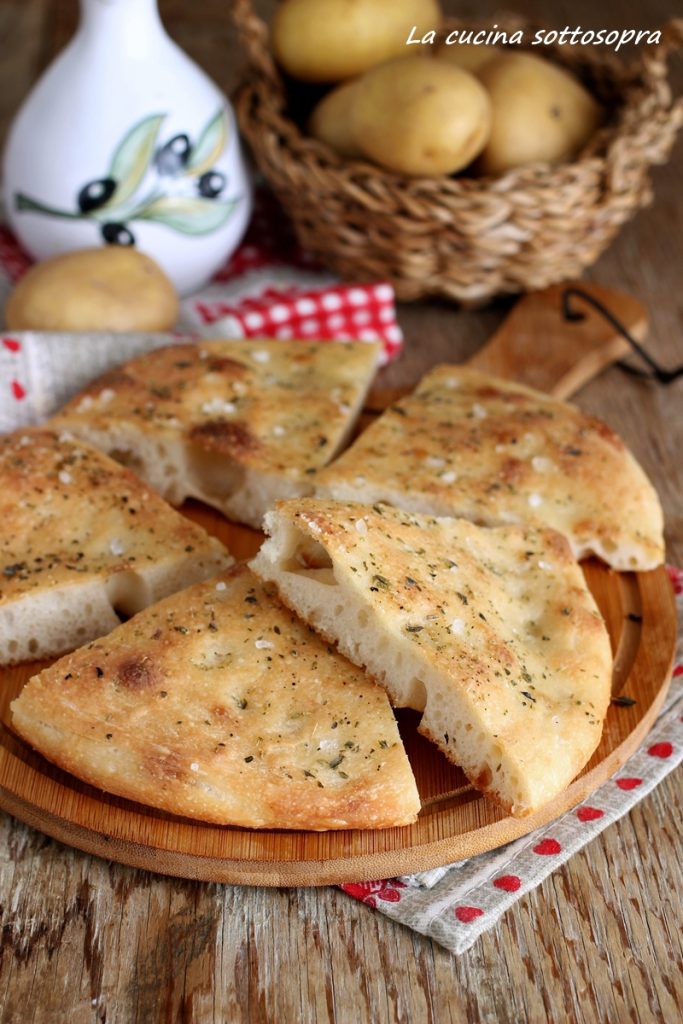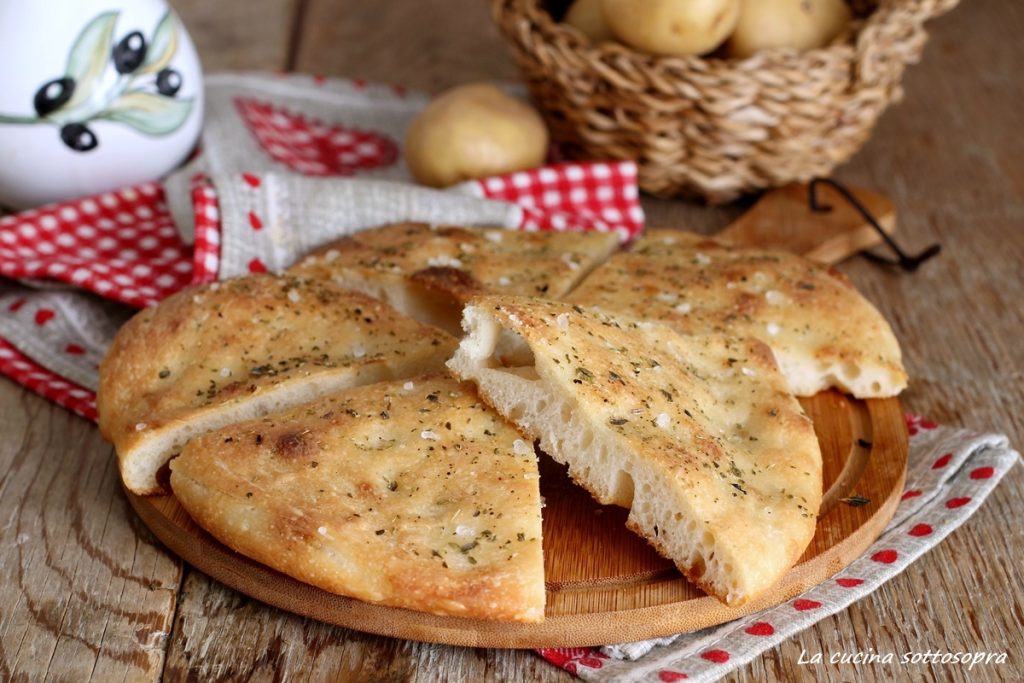The potato focaccia is a recipe you must note in your recipe book because it is one of those recipes that, once tried, you won’t let go.
This incredibly soft focaccia won me over immediately: I am a lover of savory dishes, especially the focaccia barese and panzerotti, but this focaccia with potatoes in the dough is truly delicious, on par with Nino’s focaccia, which, however, uses raw potato. It has a unique taste, also given by the potato and semolina, and has a really soft consistency… believe me, stopping at just one piece is really difficult!
The strength of this potato focaccia is precisely its simplicity. It has few ingredients, but above all, you can dress it as you prefer!
The version I propose in this recipe is the simplest one, that is white, simply dressed with a few grains of coarse salt and a pinch of aromatic herbs. In this version, I often prepare it at home and we use it as a “bread substitute” on special occasions or as an accompaniment to cold cuts and cheeses.
If, instead, you want to prepare it dressed, you can try it with the classic cherry tomatoes, oregano, and olives (as in the classic Apulian focaccia), or with sliced red onions or the vegetable version, with potatoes and bacon, and so on.
The quantities I’ll give you are for about 2 focaccias of 28 cm (if you want them thin like the one you see in the photo), but if you prefer it thicker or with more crumb, you can use smaller trays or a 40 cm focaccia tray.
In short, as I was saying, this is definitely a recipe to note down, as it lends itself to a thousand variations, according to your needs.
Before moving on to the recipe, here are some links that may interest you!

- Difficulty: Easy
- Cost: Very economical
- Rest time: 4 Hours
- Preparation time: 20 Minutes
- Portions: 12
- Cooking methods: Oven
- Cuisine: Italian
- Seasonality: All seasons
- Energy 284.75 (Kcal)
- Carbohydrates 45.87 (g) of which sugars 2.55 (g)
- Proteins 7.42 (g)
- Fat 8.67 (g) of which saturated 1.22 (g)of which unsaturated 0.28 (g)
- Fibers 2.37 (g)
- Sodium 945.13 (mg)
Indicative values for a portion of 100 g processed in an automated way starting from the nutritional information available on the CREA* and FoodData Central** databases. It is not food and / or nutritional advice.
* CREATES Food and Nutrition Research Center: https://www.crea.gov.it/alimenti-e-nutrizione https://www.alimentinutrizione.it ** U.S. Department of Agriculture, Agricultural Research Service. FoodData Central, 2019. https://fdc.nal.usda.gov
Ingredients for the potato focaccia
- 7 oz remilled durum wheat semolina
- 7 oz all-purpose flour
- 1 potato (boiled, about 150-200 g raw weight)
- 1 1/8 cups water (cold)
- 2 tsp sugar
- 1 tbsp fine salt
- 1 1/2 tbsp extra virgin olive oil
- 2 tsp fresh yeast (or 1 tsp dry yeast)
- to taste coarse salt
- to taste aromatic herbs (Oregano, thyme, rosemary…)
- to taste extra virgin olive oil
Tools to prepare the potato focaccia
- Saucepan
- Kitchen Scale
- Stand Mixer
- Baking Tray 40 cm blue iron
Steps to prepare the potato focaccia
Let’s see together how to make this delicious and super soft focaccia with boiled potatoes in the dough
Boil the potato: First of all, weigh a medium-sized raw potato weighing about 200 g. Wash the skin well under running water, then place it in a saucepan with cold water and bring to a boil. Once it starts boiling, cook for about 20 minutes, until the potato is soft but not overcooked. You’ll know the potato is cooked when you can easily pierce it with a fork. Let it cool completely, then peel it and mash it with a fork.
Dissolve the yeast: In a small bowl, dissolve the fresh yeast with a bit of water (taken from the total 260 ml) and 2 teaspoons of sugar (equivalent to about one heaped teaspoon).
Preparation of the dough: In the bowl of the stand mixer, add the flour, semolina, and the cooled, mashed boiled potato. Start the mixer at a low speed and begin working.
With the mixer running, add the oil, the water in which you dissolved the yeast, and then also the remaining cold water, which should be poured in a stream.
When the dough begins to take shape, finally add the salt.
Increase the speed of the stand mixer slightly and work the dough for about ten minutes or until it is smooth. You will know the dough is ready because it will appear smooth, cling to the mixer hook, and come away from the sides of the bowl.
Once ready, put the dough to rise.
First rising: Lightly oil a bowl and place the dough inside. Cover it with plastic wrap or a lid and let the dough rest until it doubles. This may take 2 hours (if it’s warmer) to 3 hours, as rising times are relative and depend on many factors.
Focaccia shaping and second rising: Once the potato focaccia dough has doubled, oil the bottom of the baking tray (or trays) with a little extra virgin olive oil and pour the risen dough into it. Obviously, if you use two trays, the dough should be divided in two and placed in each tray.
Let the dough rest in the tray without spreading it for 15 minutes: this will allow the dough to “relax” and make it easier to spread.
After this time, with your fingertips, starting from the center, gently spread the dough towards the edges, taking care not to deflate the risen dough too much.
Season your potato focaccia with a few grains of coarse salt, some aromatic herbs of your choice, and a drizzle of oil on top.
Let the focaccia rest until it doubles (about an hour).
Baking the potato focaccia: Once the second rising time has passed, preheat the oven to 230°F and once it reaches temperature, bake the focaccia and cook for about 15-20 minutes.
If you prepare it white (i.e., follow this recipe), be careful with the baking to avoid burning it. The focaccia should be golden on the surface, so adjust the baking time according to your oven.
Once ready, take it out of the oven, let it cool slightly, and enjoy it right away! Potato focaccia is great as a snack or to enrich the bread basket or accompany dinners and lunches.

How to store the white focaccia:
– If the potato focaccia should be left over, you can store it in food bags and consume it the next day, heated for a few minutes in the oven at 100°F. Alternatively, you can also freeze it, always portioned and always in freezer bags, and thaw it when needed.
FAQ (Frequently Asked Questions)
Can I use less yeast?
Certainly. The amount of yeast is always a bit controversial. I used an amount that allows for same-day focaccia preparation, but the amount of yeast is relative: for example, if it’s warmer, even with 4-5 g of yeast, the focaccia will rise in a day. Likewise, if it’s very cold and you need to prepare the focaccia relatively quickly, significantly increase the yeast.
If I want to prepare the focaccia for Sunday lunch, how should I organize myself?
Leavened doughs always require a bit of organization, and to be honest, my fear is always that they won’t rise enough or in time when I decide to prepare focaccia for a special occasion. For this reason, I organize myself in two ways: in the first case, I boil the potatoes the night before and then the next morning, early, I knead and shape the focaccia, so that by lunchtime I have my steaming focaccia. In the second case, I prepare the focaccia entirely the day before, but when I go to bake it, I cook it only for 10 minutes, just enough to stop the leavening. The next day I preheat the oven to 220-230°F and finish cooking the focaccia for another 10-15 minutes. The focaccia will be as if freshly made….try it to believe it!
Why should I use cold water for kneading?
It’s an old belief to use warm or even boiling water for kneading bread, pizza, and leavened products in general, thinking it will help the dough grow. In reality, it’s quite the opposite, as heat is not only the enemy of yeast (which with excessive heat can even die and thus not allow the dough to rise at all), but it’s also the enemy of the so-called gluten network, which allows us to trap air and bubbles inside the dough that form during leavening and give us a soft, bubbly dough. For this reason, since the dough already heats up during processing, it’s advisable to use cold water or even ice water in summer, as the cold water allows for perfectly binding the dough without overheating it and also has the ability to increase the extensibility of the gluten network, i.e., the ability to stretch without breaking.

